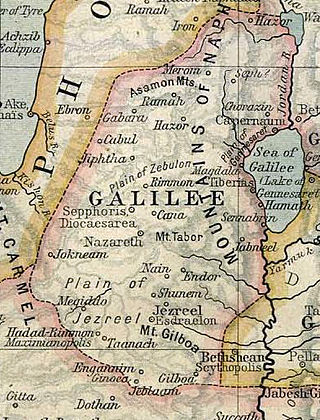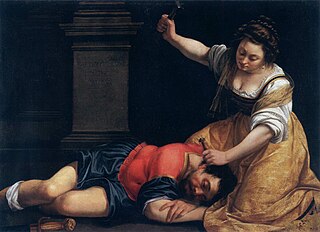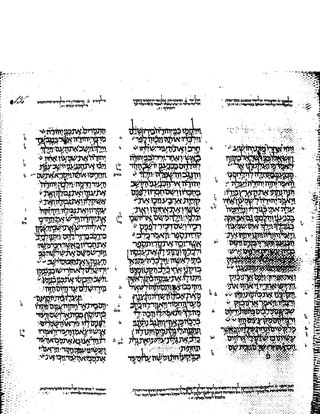
The Book of Judges is the seventh book of the Hebrew Bible and the Christian Old Testament. In the narrative of the Hebrew Bible, it covers the time between the conquest described in the Book of Joshua and the establishment of a kingdom in the Books of Samuel, during which Biblical judges served as temporary leaders.
Zaanaim, Zaanannim or Bezaanaim is a place name applied to one or two locations in the Hebrew Bible. According to Serge Frolov (2013), its location "cannot be determined with any degree of certainty."

Sisera was commander of the Canaanite army of King Jabin of Hazor, who is mentioned in Judges 4–5 of the Hebrew Bible. After being defeated by the forces of the Israelite tribes of Zebulun and Naphtali under the command of Barak and Deborah, Sisera was killed by Jael, who hammered a tent peg into his temple while he slept.

According to the Book of Judges, Deborah was a prophetess of Judaism, the fourth Judge of pre-monarchic Israel and the only female judge mentioned in the Hebrew Bible. Many scholars contend that the phrase, "a woman of Lappidoth", as translated from biblical Hebrew in Judges 4:4 denotes her marital status as the wife of Lapidoth. Alternatively, "lappid" translates as "torch" or "lightning", therefore the phrase, "woman of Lappidoth" could be referencing Deborah as a "fiery woman." Deborah told Barak, an Israelite general from Kedesh in Naphtali, that God commanded him to lead an attack against the forces of Jabin king of Canaan and his military commander Sisera ; the entire narrative is recounted in chapter 4.

Barak was a ruler of Ancient Israel. As military commander in the biblical Book of Judges, Barak, with Deborah, from the Tribe of Ephraim, the prophet and fourth Judge of pre-monarchic Israel, defeated the Canaanite armies led by Sisera.

According to the Hebrew Bible, the Kenites/Qenites were a tribe in the ancient Levant. They settled in the towns and cities in the northeastern Negev in an area known as the "Negev of the Kenites" near Arad, and played an important role in the history of ancient Israel. One of the most recognized Kenites is Jethro, Moses's father-in-law, who was a shepherd and a priest in the land of Midian. Certain groups of Kenites settled among the Israelite population, including the descendants of Moses's brother-in-law, although the Kenites descended from Rechab maintained a distinct, nomadic lifestyle for some time.

Endor was a Canaanite city, which is listed in the Book of Joshua as one of the cities the Israelites failed to dispossess, neither the city nor its dependencies. It was located between the Hill of Moreh and Mount Tabor in the Jezreel Valley. It is mentioned twice more in the Hebrew Bible, in 1 Samuel and in Psalm 83.

Jael or Yael is a heroine of the Battle of Mount Tabor, described in chapters 4 and 5 of the Book of Judges. In the account, she delivers the Israelites from the army of King Jabin of the city of Hazor in Canaan. After Barak demurs at the behest of the prophetess Deborah, God turns Sisera over to Jael, who kills him by driving a tent peg through his skull after he enters her tent near the great tree in Zaanaim near Kedesh.
Jabin is a Biblical name meaning 'discerner', or 'the wise'. It may refer to:
Meroz is a city mentioned in the Book of Judges.

Deborah is an oratorio by George Frideric Handel. It was one of Handel's early oratorios in English and was based on a libretto by Samuel Humphreys. It received its premiere performance at the King's Theatre in London on 17 March 1733.

Mount Tabor is a large hill of Biblical significance in Lower Galilee, Northern Israel at the eastern end of the Jezreel Valley, 18 kilometres (11 mi) west of the Sea of Galilee.

Dèbora e Jaéle is an opera in three acts composed by Ildebrando Pizzetti who also wrote the libretto. The libretto is based on the story of Deborah and Jael from the Book of Judges in the Bible. However, it differs in several ways from the traditional Biblical account, primarily in the motivations of its characters and the relationships between them. The opera was first performed at La Scala, Milan on 16 December 1922.

Harosheth Haggoyim is a fortress described in the Book of Judges as the fortress or cavalry base of Sisera, commander of the army of "Jabin, King of Canaan".

The Kenite hypothesis proposes that the origins of Yahweh, and by extension Yahwism, do not lie in Canaan, but instead originated in the area immediately south of the Levant, the northwest Arabian Peninsula, on the east shore of the Gulf of Aqaba on the Red Sea, in the area the Tanakh calls "Midian". The theory states that Yahweh originally was a Midianite deity, who made his way up north to the proto-Israelites.

Jael and Sisera is a painting by the Italian Baroque artist Artemisia Gentileschi, executed around 1620.

Judges 4 is the fourth chapter of the Book of Judges in the Old Testament or the Hebrew Bible. According to Jewish tradition the book was attributed to the prophet Samuel, but modern scholars view it as part of the Deuteronomistic History, which spans the books of Deuteronomy to 2 Kings, attributed to nationalistic and devotedly Yahwistic writers during the time of the reformer Judean king Josiah in 7th century BCE. This chapter records the activities of judge Deborah, belonging to a section comprising Judges 3:1 to 5:31.

Judges 5 is the fifth chapter of the Book of Judges in the Old Testament or the Hebrew Bible. According to Jewish tradition the book was attributed to the prophet Samuel, but modern scholars view it as part of the Deuteronomistic History, which spans the books of Deuteronomy to 2 Kings, attributed to nationalistic and devotedly Yahwistic writers during the time of the reformer Judean king Josiah in the 7th century BCE. This chapter records the activities of judge Deborah, belonging to a section comprising Judges 3:1 to 5:31.
War in the Hebrew Bible concerns any military engagement narrated or discussed in the Hebrew Bible, also known as the Tanakh or Old Testament of the Bible. Texts about war in the Hebrew Bible are part of the broader topic of The Bible and violence. They cover a wide range of topics from detailed battle reports including weapons and tactics used, numbers of combatants involved, and casualties experienced, to discussions of motives and justifications for war, the sacred and secular aspects of war, descriptions and considerations of what in modern times would be considered war crimes such as genocide or wartime sexual violence, and reflections on wars that have happened, or predictions, visions or imaginations of wars that are yet to come.

According to the Hebrew Bible, the Tribe of Zebulun was one of the twelve tribes of Israel. Following the completion of the conquest of Canaan by the Israelite tribes in the Book of Joshua, Joshua allocated the land among the twelve tribes. The territory Zebulun was allocated was at the southern end of the Galilee, with its eastern border being the Sea of Galilee, the western border being the Mediterranean Sea, the south being bordered by the Tribe of Issachar, and the north by Asher on the western side and Naphtali on the eastern.















